The 1955 Flood on the Norwalk River
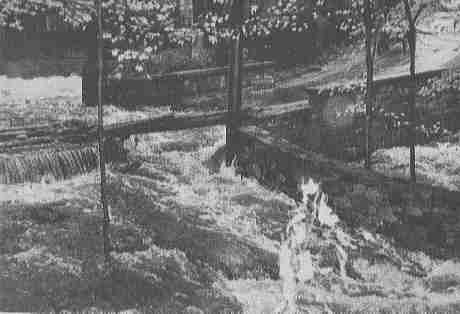
“A Pictorial Review”, p. 58
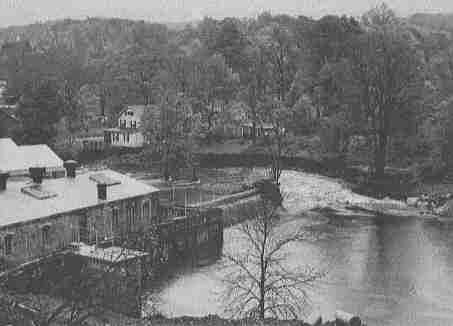
Bennett factory in Georgetown.
“A Pictorial Review”, p.56
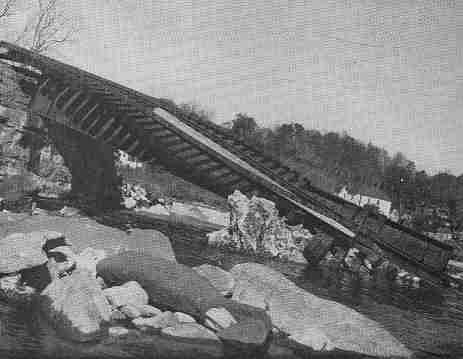
MARK Photo by Malowsky
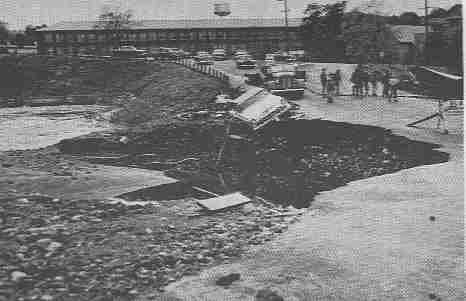
Wilton Bulletin, Clarence Korker
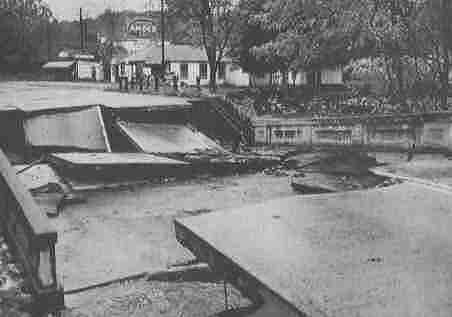
“A Pictorial Review”, p.55
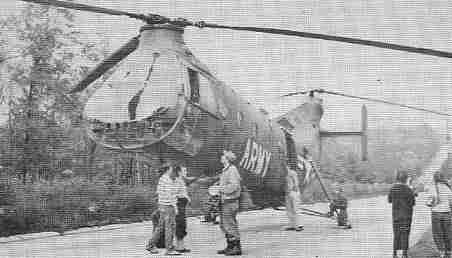
New Canaan Advertiser
The Flood of October, 1955
by Brent M. Colley Posted 09/20/05
In 1955, the worst natural disasters to strike Connecticut since the hurricane of 1938 occurred within a 2-month span. Two hurricanes, one tropical storm and a pair of floods ravaged homes and businesses throughout the state in the months of August and October.
The August disaster was a result of back-to-back hurricanes in mid-August 1955. Hurricanes Connie and Diane arrived toward the end of a wetter-than-usual summer, combining to drop over 24 inches of rain on the Northern regions of Connecticut between August 13th and August 20th , leaving record levels of flooding and widespread havoc in their wake.
Many Connecticut rivers, particularly the Housatonic, Naugatuck, Still, Quinebaug, Mad, and Farmington, overflowed their banks as never before; towns and cities in Litchfield and Hartford counties were particularly hard hit. The downtowns of many cities were devastated, including Winsted where the downtown was completely washed away. Property damage mounted into the tens of millions of dollars. Almost 100 people were killed, an estimated 4,700 were injured, and countless others were left homeless.
Surprisingly, towns and residents of the Norwalk and Saugatuck Watershed in the Southwestern section of Connecticut did not sustain rainfall accumulations as high as those to the north and were spared of flood conditions in August. Their time was yet to come.
In October, a four day tropical storm dumped an additional 12-14 inches of rain on southwest New England. This event was not as widespread as the August storms; however, the Flood of October, 1955 was devastating to the local communities along the Norwalk and Saugatuck Rivers. Millions of dollars and several lives were lost as a result of the rains that fell between Friday Oct. 14 and Monday Oct. 17th, 1955.
*Newspaper reports from several local publications varied greatly on the amount of rain and the amount of time it fell in. These numbers varied from the 12.58 inches reported by Georgetown Weatherman’s George Howes to as much as 13.88 inches reported in Ridgefield. The timeframe also varied from 36 hours to 48 hours depending on source of information. Regardless of the exact amount and timeframe, a great deal of rain fell upon an already saturated watershed on the weekend of October 14th, 1955.
All of Fairfield County was hit, but Branchville, Georgetown, Norwalk, Wilton and sections of Ridgefield were hit worse, because of the Norwalk River.
According to Charles Howes, Georgetown’s weather observer, and his assistant Conrad Borgensen. Starting at 7am on Friday morning, Mr. Howes recorded .62 inches by 5:30pm, and another 2 inches by midnight. By noon Saturday another 2.23 inches had fallen; and during the next 24 hours 7.82 inches of rain was dumped upon this area.
By mid-afternoon Saturday, the Georgetown Fire Department and all available men were stationed at the bridges into town and at Branchville. The danger: fire and/or explosions from the washed-out gasoline tanks of the Branchville Motors garage, their contents riding the crest of the flood, causing alarm for several hours.
By 6pm the Norwalk River had flooded Route 7 from Branchville Station to just south of the Georgetown Motors garage. The Branchville train station, businesses and homes in the area were swamped, the bridge near Branchville cemetary completely washed away.
Shortly after 6pm residents were evacuated from Branchville and Georgetown, some by boat, others by heavy-duty trucks. Residents that did not have relatives or friends they could not reach in the area were taken the Georgetown Firehouse where they remained overnight.
The Press reported the Peatt family on Mamanasco Lake brought in boats and “went to Branchville to rescue some people whose houses were surrounded by still rising waters of the Norwalk River.”
Nazzareno Ancona reported seeing the gas station on Route 7 flooded with water half-way up the garage door, water coming in the back door and coming out the front door “bringing everything with it,” he said.
The dam at Perry’s Pond, on Route 53, above Georgetown (now Route 107) gave way a little before 9pm Saturday night sending a rush of water into the heart of Georgetown. In addition, there was a landslide about a half mile up Route 53 (now Route 107), but cars were able to get through.
At 9pm a northbound train out of Norwalk came to a halt in the “wilds” between Honey Hill and Seeley Roads in Cannondale. The stalled train and its 83 passengers would remain stranded for the next 14 hours until three U.S. Army helicopters were able to airlift them to safety in a rescue mission that spanned 3 hours. They were all transported to Danbury via buses.
By 10:30pm water was 4 feet deep in the center of Georgetown. Factory pond was so high that residents later reported water up to their porches on Portland Avenue.
The nearly 8 inches of rain that fell between Saturday and Sunday taxed the dams along the Norwalk River, in all likelyhood already fatigued by the storms of August, to such an extent that at approximately 10:30pm the dam at Great Pond gave way, sending a surge of water through the Norwalk River Valley with such force that all dams and most of the bridges in its path crumbled in its wrath.
The concrete bridge on Route 7 which is parallel to the railroad trestle (between DeLuca’s Hardware and Bob Sharp), crashed into the river just before 11pm Saturday night, and shortly after that the trestle, undermined by the flood waters, collapsed as well leaving the tracks still spanning the river, but with no visable means of support.
At approximately 11pm, there was an audible “pop” as the embankment surrounding the the dam that had served the Gilbert & Bennett factory for over 100 years gave way sending water levels in Georgetown and through the factory to heights estimated from 8 to 12 feet deep.
Connery’s Lumber Yard was washed away when the dam broke at the factory, and evidences of it could be found as far down the Norwalk River as Cannondale.
It’s safe to say Harold Connery was a good humored man… Following the Flood, Harold was asking all his customers downstream if they had received the shipments of lumber he sent them.
The dam at the “old mill” (Old Mill Road) went shorty after the dam at the factory gave way, sending more tons of water down the valley.
As dams to the north succumbed to the avalanche of water surging down the valley, Cannondale and Wilton were next in the river’s path of destruction. Flood waters inflicted heavy damage on the New Haven Railroad tracks at several points in Wilton. The trestle in Cannondale, just below what was left of the Cannon Grange Hall, collapsed. At the northern approach to the Cannondale trestle, the tracks twisted crazily off their embankment; and were seriously undermined at several other points throughout Wilton.
Four Wilton bridges spanning the Norwalk River – at Honey Hill, Seeley, Old Ridgefield, and Kent Roads – were wiped out, as were bridges at Silver Spring and Cedar Roads. Washouts made other bridges at Old Mill Road, Wolfpit Road, Arrowhead Road and Cannondale impassable; but these washouts and others in Silvermine were patched up with gravel on Monday and Tuesday by town road crews and contractors.
In houses along Cottage Row in the center of Wilton which frequently experienced cellar floods but nothing worse, the water rose above the main floors- almost to the ceilings in the Grover Bradley and George Barringer homes. The home of Mrs. Millie Beers in South Wilton was twisted off its foundation. Mrs. Beers was rescued by two firemen.
The Silvermine River in the southwest corner of Wilton also went on a rampage. Several families along the river fled their homes as the raging waters threatened to wash them away. Many evacuees spent the night with neighbors; several families slept in the Wilton Congregational Church and parsonage, the firehouse and town hall.
Over in Redding the damage was primarily roadway and bridge wash-outs along the Saugatuck and its tributaries.
The small brook that courses down Route 53 (now 107), at the top of the Glen Hill, became a raging torrent undermining the road there. The road was passable until late Monday afternoon when, S. Harold Samuelson, first selectman of Redding, ordered the road closed.
Halfway down the Glen Hill, a landslide blocked the highway until Sunday afternoon, when a bulldozer pushed a one-way lane through it. At the foot of Glen Hill, the road was impassable over the bridge at the junction of Routes 53 and 107; the bridge withstood the raging Saugatuck, but the roadway was completely washed away on either side. On Monday afternoon, a car was still standing in a deep hole that had been the approach to the bridge, leaning crazily against a telephone pole. Further downstream was another car in the river. Its occupants had abandoned it on the road Saturday night.
Upstream was the site of the tragedy which saddened the whole town. At the Diamond Hill Road bridge, Edward Arthur Phoenix, 53, and his wife, Veronica, 47, of Fox Run Road lost their lives on Saturday night when the Phoenix’s car was swept into the river below the bridge. Mr. and Mrs. Phoenix were coming home from dinner at the home of Mr. and Mrs. Matthew Blair of Great Pasture Road.
A three and one-half hour frantic and near successful attempt to rescue Mrs. Phoenix from a tree, after her husband had been swept to his death, made the tradegy even more horrifying. While volunteer firemen and neighbors tried vainly to reach her in the darkness she clung doggedly to the tree, aware of the efforts to save her. But at length her strength failed and she fell into the river and drowned. At one time the rescuers were within 20 feet of the tree but were turned aside by the tremendous force of the torrent.
An Army helicopter spotted the women’s body Monday Morning, 1,500 feet from the Diamond Hill Bridge. Mr. Phoenix’s body was recovered early Tuesday about 50 feet further downstream.
All approaches to West Redding were blocked; not a bridge was left intact by the tributaries of the Saugatuck River. Route 53 all the way to Bethel was blocked, the only route to Bethel or Danbury left open was the Black Rock Turnpike, which people reached by devious ways.
The Aftermath
The Red Cross survey team of Morris Earle, disaster chairman; Thomas Donahue and J. Andrew Squires reported that 9 businesses along the Norwalk River suffered total loss of inventory; 26 received major flood damage ranging up to total loss, and 19 suffered minor damage. They said the water reached the first flood or higher in 70 houses along the Norwalk River, and probably more than 15 others in southwest and southeast corners of town. More than 1,000 cellars were flooded, they estimated.
Hardest hit in this area was Georgetown where the Gilbert and Bennett Manufacturing plant’s dam gave way, sending nine feet of rampaging river water rolling down Main Street wiping out stocks and equipment in restaurants, groceries and other business establishments, and undermined several buildings.
Along Main Street, the damage was incredible. The new Calso Building, which housed Sansevieri’s Barber Shop (opened just 3 weeks prior to the flood), J.C. Driscoll’s Real Estate (opened just one week prior to the flood) suffered heavy damage. Steve’s Bakery which open just 2 week prior to the flood was considered a complete loss. Bonsignore’s Market was also a total loss. The Local Shoemaker, Georgetown Electric, Sabilia’s Liquor store, Georgetown Restaurant, Bennie’s Restaurant, Perry’s Market all ruined. Connery Brothers’ new building supply store withstood the flood, being on higher ground. The main store, on the opposite side of Route 57, while undamaged, stood as an island, the surrounding highway being washed away.
The three garages in Branchville: Branchville Service and Oil, Branchville Motors and Georgetown Motors were all damaged by the flood. Branchville Motors the worst of all. Archie Parent, the owner, had gotten his used cars to higher ground before they were washed away, but most of his supplies were down by the river Sunday morning.
Route 7 was flooded and washed out in several places, including the concrete bridge near Sunset Pass in Georgetown (Bob Sharp Motors, DeLuca’s Plaza area) which fell into the river on Saturday night. Traffic was detoured at that point via Old Danbury Road and across the much older bridge which withstood the flood.
Traffic through the town was re-routed to so many different roads, that most people stopped to ask “is such and such road open?”, rather than take the chance of finding that the road was blocked. Roads that were passable Sunday and even Monday, suddenly developed breaks, and people who didn’t have to travel were being asked to remain at home.
Wilton’s and Ridgefield’s flood problems were further complicated by the Silvermine River’s undermining of the Silvermine Bridge on Merritt Parkway in Norwalk. Parkway and Route 1 traffic was detoured up Wilton-Westport Road to the Route 7 traffic light in Wilton and up the Ridgefield-Wilton Road to Route 35 at the Ridgefield Congregational Church.
Local police, firemen and Red Cross and Civil Defense volunteers directed traffic at the intersections along the detour. Cars and heavy trucks moved slowly bumper to bumper along the entire route much of Sunday afternoon and at frequent intervals during the four days that followed.
The Press reported on Oct. 20, 1955: 90% of roads were “washed out to some degree.”
Hard-surfaced and gravel roads in most areas were washed out by drain water or small streams which burst over their culverts, ripping deep holes in the highways.
All Wilton Schools were ordered closed in the week following the flood, primarily as a health measure, due to the possibility that the water supplies at the Junior High, Center School and Gorham House may have been contaminated. Center School was also without heat, since its electric motors were knocked out by flood waters.
Disruption of bus route by road and bridge washouts also contributed to school closings; school officials and bus contractors worked on route revisions all week.
Some 700 persons who lived or worked in the flooded areas bared their arms for Typhoid shots Monday and Tuesday, at an emergency clinic set up at Wilton Town Hall by Dr. Henry Appelbaum, public health director.
Governor Abraham Ribicoff and his aides landed in two Army helicopters at the playground of the Gilbert & Bennett school Tuesday afternoon, to see first-hand the damage to Georgetown and Redding. The governor was greeted by Harold Samuelson, Redding’s First Selectman; John H. Mulliken, president of Gilbert & Bennett Manufacturing Company, and other company officials. Escorted by state police, the governor made a tour of the factory, then later took off to fly over Redding.
While in Georgetown, Governor Ribicoff also inspected damage along Main Street and walked into Kearn General Store which was among those washed out when the nine foot wall of water hit Main Street. Operated by Herbert Kearns and his family for 49 years, the store had missed few, if any days of business in that time. When it was moved 30 or 40 feet to make room for the new highway (Rt. 107), business went on as usual.
“What are you going to do now?” the governor asked as he gazed around the soaked merchandise and three inches of muck on the floor.
“Governor, I just don’t know,” Mr. Kearns replied, “I haven’t made up my mind yet.”
The Clean-up
The volunteer effort in the aftermath of this great disaster exemplifies the character of the individuals living in this area at this time period. Dogged, gritty, determined, steadfast, unwavering are words that come to mind when recounting the clean-up efforts and acts of neighbory kindness in this time of tragedy.
Gilbert and Bennett employees, the Georgetown Fire Department and all available men and women in the area took part in the heart-breaking task of cleaning up Georgetown, a job they had been at since Saturday night.
The flood caused almost $1 million worth of damage to the Gilbert and Bennett mill alone.
*John Mulliken recalled in 1959 that: “It took us 137 years to get together a little over $800,000 in Government Bonds and they went out the window in less than an hour when the flood hit us.”
Despite the destruction, the company reopened two months later as employees and local contractors joined together in the clean up effort and in spite of the flood’s devastation the company still produced 2.6 million miles of wire in 1955…an amount that would reach 104 times around the world.
The Georgetown and Redding fire departments sent men and pumps out to empty flooded cellars so that people could get their heating units in working condition. Some of these men worked around the clock for 3 days.
Members of the Civilian Defense units were also on duty in Branchville, Georgetown and Redding. Many of them up to Tuesday morning had had no sleep since the flood struck the area, and few of them had hope of being relieved.
With many people in Branchville, Georgetown and Redding low on food, neighbors with operational freezers helped out those less fortunate.
Harold Connery, head of Connery Brothers, sent his trucks to Bethel and Danbury to for additional food and supplies. Connery’s was the only food store in town undamaged by the flood, but he did not rejoice in his good fortune, instead he served those in need.
Wilton health director, Dr. Henry Applebaum, obtained from the State a supply of lime for decontaminating water supplies and buildings. It was made available at the town hall in Wilton, together with decontamination instructions.
All men, working in the flood areas, such as the Gilbert and Bennett factory, received typhoid inoculations from Dr. P.T. McIlroy. Mrs. Julius Johnson assisted Dr. McIlroy in the mass inoculations.
Could it happen again?
We must keep in mind that flooding is a natural process for rivers, producing many beneficial side effects such as the distribution of fresh water over a wide area to replenish groundwater supplies that are critical for the private wells that many households depend upon. But in a congested region like Fairfield County, floods can also pose a great threat to life and property.
The Norwalk River has not had a significant flood since 1955. A modern repeat of the 1955 flood would do over $21 million in damage along the river. On the 50th anniversary of the Flood of ’55 perhaps it is appropriate to point out three simple steps that both local municipalities and residents can take to help lessen the dangers of flooding in our area.
Wetland Conservation
The Federal Emergency Management Agency (FEMA) encourages the use of wetlands for flood and storm water detention in lieu of, or in conjunction with traditional structural flood control measures. Wetlands can play an important role in flood prevention by capturing and gradually releasing floodwater, rain, and snow melt back into the watercourse, thus lowering peak flows downstream. In addition, the physical structure of wetland vegetation can impede the flow of flood waters, thereby reducing erosion, and preventing downstream damage to houses and other structures. Wetlands also help to remove pollutants from water, cleaning streams and lakes, thereby reducing the cost of drinking water treatment.
The U. S. Army Corps of Engineers has recognized the value of wetlands in preventing flood damage. In 1983, the Corps concluded that conserving wetlands was a less expensive solution to flooding than the construction of dikes and dams.
Increase Riparian Buffers, Decrease Flood Severity
Healthy riparian zones can reduce severity of flooding during heavy rains in three ways:
The stream’s natural characteristics are preserved. Vegetation on and above the streambank provides friction against moving water, which slows it down so water is not delivered downstream as quickly. Water that floods into such an area also re-enters the main channel slowly. A meandering stream increases the storage potential of the channel, once again, slowing water movement and reducing flood potential.
Native trees, shrubs, and grasses route water under ground. The dense stems of grass, shrubs, and trees in the riparian zone further slow water, allowing it to infiltrate into the “soil sponge.” Root systems of this vegetation keep pores of the soil open so that two to three times more water can enter the soil compared to a soil used for cultivation or grazing. Water in the soil is released slowly into the stream.
Transpiration of plants reduces water in the soil. Trees, shrubs, and grass use large amounts of water in transpiration. Several thousand gallons per acre of water are used by plants each day, thereby drying the soil and making more room in the “soil sponge” for floodwater. The transpiration process also is responsible for taking large amounts of nutrients and chemicals into plants where much of it is locked up in storage.
Do your part…Don’t Dump Leaves into Waterways or Wetlands
Whether it’s in the spring when homeowners, renters, and professional yardmen are hastening to rake up last fall’s leaves and cut back deadwood to encourage the new growth that has started to push through the earth or it’s during the great fall cleanup, any time is a good time to remember that none of those raked leaves and collected clippings should find their way into any waterway or wetland.
Excess leaves can clog culverts, fill ponds or the backside of a dam, and make the river shallower and more prone to flooding or the need for expensive dredging. Property owners should let anyone who works with them or for them know that this material should not be blown or dumped into any river, pond, or wetland. No matter which waterway or wetland is a dumping target, dumping in those sensitive areas can have serious consequences.
Media and individuals can download the article here.
Flood Photos
Very few photos were taken at the height of the storm. The pictures shown here come from two photo collections that were published immediately after the event: “A Pictorial Review of the Danbury and Northern Fairfield County Flood of Oct 15-16, 1955” published by the Danbury Printing Co. and generally lacking photo credits, and “The Night of October 15, 1955: MARK Flood Disaster Pictorial”, published by MARK Publications, Inc., 64 Wall St., Norwalk. The latter has many original photos plus others that are credited to local individuals and news organizations.
These two photo collections were kindly provided to us by Jack Sanders, Executive Editor of the Ridgefield Press, a Hersam Acorn publication, to whom we express our thanks. The newspaper-quality photos from the 1950’s have been further degraded in the scanning process, preparing them for this website, but we think they still provide a good impression of what happened on that very memorable weekend, nearly a half-century ago.
